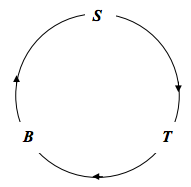15.3: Desmagnetización adiabática
- Page ID
- 127808
\( \newcommand{\vecs}[1]{\overset { \scriptstyle \rightharpoonup} {\mathbf{#1}} } \)
\( \newcommand{\vecd}[1]{\overset{-\!-\!\rightharpoonup}{\vphantom{a}\smash {#1}}} \)
\( \newcommand{\id}{\mathrm{id}}\) \( \newcommand{\Span}{\mathrm{span}}\)
( \newcommand{\kernel}{\mathrm{null}\,}\) \( \newcommand{\range}{\mathrm{range}\,}\)
\( \newcommand{\RealPart}{\mathrm{Re}}\) \( \newcommand{\ImaginaryPart}{\mathrm{Im}}\)
\( \newcommand{\Argument}{\mathrm{Arg}}\) \( \newcommand{\norm}[1]{\| #1 \|}\)
\( \newcommand{\inner}[2]{\langle #1, #2 \rangle}\)
\( \newcommand{\Span}{\mathrm{span}}\)
\( \newcommand{\id}{\mathrm{id}}\)
\( \newcommand{\Span}{\mathrm{span}}\)
\( \newcommand{\kernel}{\mathrm{null}\,}\)
\( \newcommand{\range}{\mathrm{range}\,}\)
\( \newcommand{\RealPart}{\mathrm{Re}}\)
\( \newcommand{\ImaginaryPart}{\mathrm{Im}}\)
\( \newcommand{\Argument}{\mathrm{Arg}}\)
\( \newcommand{\norm}[1]{\| #1 \|}\)
\( \newcommand{\inner}[2]{\langle #1, #2 \rangle}\)
\( \newcommand{\Span}{\mathrm{span}}\) \( \newcommand{\AA}{\unicode[.8,0]{x212B}}\)
\( \newcommand{\vectorA}[1]{\vec{#1}} % arrow\)
\( \newcommand{\vectorAt}[1]{\vec{\text{#1}}} % arrow\)
\( \newcommand{\vectorB}[1]{\overset { \scriptstyle \rightharpoonup} {\mathbf{#1}} } \)
\( \newcommand{\vectorC}[1]{\textbf{#1}} \)
\( \newcommand{\vectorD}[1]{\overrightarrow{#1}} \)
\( \newcommand{\vectorDt}[1]{\overrightarrow{\text{#1}}} \)
\( \newcommand{\vectE}[1]{\overset{-\!-\!\rightharpoonup}{\vphantom{a}\smash{\mathbf {#1}}}} \)
\( \newcommand{\vecs}[1]{\overset { \scriptstyle \rightharpoonup} {\mathbf{#1}} } \)
\( \newcommand{\vecd}[1]{\overset{-\!-\!\rightharpoonup}{\vphantom{a}\smash {#1}}} \)
Ahora vamos a hacer el mismo argumento a favor de la desmagnetización adiabática.
Vamos a calcular una expresión para\((∂T/∂B)_S\). La expresión será positiva, ya que\(T\) y\(B\) aumentarán juntos. Consideraremos la entropía como una función de la temperatura y el campo magnético, y, con las variables

comenzaremos con la relación cíclica
\[ \left(\frac{\partial S}{\partial T}\right)_{B}\left(\frac{\partial T}{\partial B}\right)_{S}\left(\frac{\partial B}{\partial S}\right)_{T}=-1. \label{15.3.1}\]
El término medio es el que queremos. Busquemos expresiones para la primera y tercera derivada parcial en términos de cosas que podamos medir.
En un proceso reversible\(dS = dQ/T\), y, en un campo magnético constante,\(dQ = C_BdT\). Aquí estoy tomando S para significar la entropía por unidad de volumen, y C B es la capacidad calorífica por unidad de volumen (es decir, el calor requerido para elevar la temperatura del volumen unitario en un grado) en un campo magnético constante.
Así tenemos\( \left(\frac{\partial S}{\partial T}\right)_{B}=\frac{C_{B}}{T}\).
La relación Maxwell correspondiente a\( \left(\frac{\partial S}{\partial P}\right)_{T}=-\left(\frac{\partial V}{\partial T}\right)_{P}\) es\(\left(\frac{\partial S}{\partial B}\right)_{T}=\left(\frac{\partial M}{\partial T}\right)_{B}\). Así la Ecuación\ ref {15.3.1} se convierte
\[ \left(\frac{\partial T}{\partial B}\right)_{S}=-\frac{T}{C_{B}}\left(\frac{\partial M}{\partial T}\right)_{B}\].
Ahora para un material paramagnético, la magnetización, para un campo dado, es proporcional a B y cae inversamente como la temperatura (esa es la ecuación de estado). Es decir, M = aB/T. y por lo tanto\( \left(\frac{\partial M}{\partial T}\right)_{B}=-\frac{a B}{T^{2}}=-\frac{M}{T}\). Por tanto, la ecuación 15.3.2 se convierte
\[ \left(\frac{\partial T}{\partial B}\right)_{s}=\frac{M}{C_{B}}.\]
Debe verificar las dimensiones de esta ecuación.
El efecto de enfriamiento es particularmente efectivo a bajas temperaturas, cuando\(C_B\) es pequeño.


